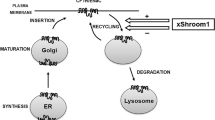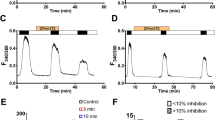Abstract
The cystic fibrosis transmembrane regulator (CFTR) is a Cl− channel known to influence other channels, including connexin (Cx) channels. To study the functional interaction between CFTR and gap junction channels, we coexpressed in Xenopus oocytes CFTR and either Cx45, Cx40, Cx32 or Cx50 and monitored junctional conductance (G j) and its sensitivity to transjunctional voltage (V j) by the dual voltage-clamp method. Application of forskolin induced a Cl− current; increased G j approximately 750%, 560%, 64% and 8% in Cx45, Cx40, Cx32 and Cx50, respectively; and decreased sensitivity to V j gating, monitored by a change in the ratio between G j steady state and G j peak (G jSS/G jPK) at the pulse. In oocyte pairs expressing just Cx45 in one oocyte (#1) and both Cx45 and CFTR in the other (#2), with negative pulses applied to oocyte #1 forskolin application still increased G j and decreased the sensitivity to V j gating, indicating that CFTR activation is effective even when it affects only one of the two hemichannels and that the G j and V j changes are not artifacts of decreased membrane resistance in the pulsed oocyte. COOH-terminus truncation reduced the forskolin effect on Cx40 (Cx40TR) but not on Cx32 (Cx32TR) channels. The data suggest a cross-talk between CFTR and a variety of gap junction channels. Cytoskeletal scaffolding proteins and/or other intermediate cytoplasmic proteins are likely to play a role in CFTR-Cx interaction.





Similar content being viewed by others
References
Bachhuber T., Konig J., Voelcker T., Murle B., Schreiber R., Kunzelmann K. 2005. Cl− interference with the epithelial Na+ channel ENaC. J. Biol. Chem. 280:31587–31594
Barrio L.C., Suchyna T., Bargiello T., Xu L.X., Roginski R.S., Bennett M.V.L., Nicholson B.J. 1991. Gap junctions formed by connexins 26 and 32 alone and in combination are differently affected by applied voltage. Proc. Natl. Acad. Sci. USA 88:8410–8414
Bear C.E., Duguay F., Naismith A.L., Kartner N., Hanrahan J.W., Riordan J.R. 1991. Cl− channel activity in Xenopus oocytes expressing the cystic fibrosis gene. J. Biol. Chem. 268:19142–19145
Bukauskas F.F., Bukauskiene A., Verselis V.K., Bennett M.V.L. 2002. Coupling asymmetry of heterotypic connexin 45/connexin 43-EGFP gap junctions: Properties of fast and slow gating mechanisms. Proc. Natl. Acad. Sci. USA 99:7113–7118
Bukauskas F.F., Peracchia C. 1997. Two distinct gating mechanisms in gap junction channels: CO2-sensitive and voltage-sensitive. Biophys. J. 72:2137–2142
Cunningham S.A., Worrell R.T., Benos D.J., Frizzell R.A. 1992. cAMP-stimulated ion currents in Xenopus oocytes expressing CFTR cRNA. Am. J. Physiol. 262:C783-C788
Chanson M., Berclaz P.Y., Scerri I., Dudez T., Wernke-Dollries K., Pizurki L., Pavirani A., Fiedler M.A., Suter S. 2001. Regulation of gap junctional communication by a proinflammatory cytokine in cystic fibrosis transmembrane conductance regulator-expressing but not cystic fibrosis airway cells. Am. J. Pathol. 158:1775–1784
Chanson M., Scerri I., Suter S. 1999. Defective regulation of gap junction coupling in cystic fibrosis pancreatic duct cells. J. Clin. Invest. 103:1677–1684
Cheng J., Guggino W.B. 1998. Molecular cloning and characterization of a novel PDZ domain containing protein that interact with CFTR. Pediatr. Pulmonol. 26(Suppl. 17):213
Cheng J., Wang H., Guggino W.B. 2004. Modulation of mature cystic fiobrosis transmembrane regulator protein by the PDZ domain protein CAL. J. Biol. Chem. 279:1892–1898
Donaldson S.H., Boucher R.C. 2003. Update on pathogenesis of cystic fibrosis lung disease. Curr. Opin. Pulm. Med. 9:486–491
Drumm M.L., Wilkinson D.J., Smit L.S., Worrell R.T., Strong T.V., Frizzell R.A., Dawson D.C, Collins F.S. 1991. Chloride conductance expressed by delta F508 and other CFTRs in Xenopus oocytes. Science 254:1797–1799
Gadsby D., Nairn A.C. 1999. Control of CFTR channel gating by phosphorylation and nucleotide hydrolysis. Physiol. Rev. 79:77–107
Greger R., Schreiber R., Mall M., Wissner A., Hopf A., Briel M., Bleich M., Warth R., Kunzelmann K. 2001. Cystic fibrosis and CFTR. Pfluegers Arch. 443:3–7
Harris A.L. 2001. Emerging issues of connexin channels: Biophysics fills the gap. Q. Rev. Biophys. 34:325–472
Huang S., Dudez T., Scerri I., Thomas M.A., Giepmans B.N., Suter S., Chanson M. 2003. Defective activation of c-Src in cystic fibrosis airway epithelial cells results in loss of tumor necrosis factor-alpha-induced gap junction regulation. J. Biol. Chem. 278:8326–8332
Kausalya P.J., Reichert M., Hunziker W. 2001. Connexin45 directly binds to ZO-1 and localizes to the tight junction region in epithelial MDCK cells. FEBS Lett. 505:92–96
Ko S.B., Shcheynikov N., Choi J.Y., Luo X., Ishibashi K., Thomas P.J., Kim J.Y., Kim K.H., Lee M.G., Naruse S., Muallem S. 2002. A molecular mechanism for aberrant CFTR-dependent HCO −3 transport in cystic fibrosis. EMBO J. 21:5662–5672
Kotsias B.A., Peracchia C. 2005. Functional interaction between CFTR and Cx45 gap junction channels expressed in oocytes. J. Membr. Biol. 203:143–150
Kunzelmann K. 1999. The cystic fibrosis transmembrane conductance regulator and its function in epithelial transport. Rev. Physiol. Biochem. Pharmacol. 137:1–70
Kunzelmann K. 2001. CFTR: Interacting with everything? News Physiol. Sci. 16:167–170
Lazrak A., Peracchia C. 1993. Gap junction gating sensitivity to physiological internal calcium regardless of pH in Novikoff hepatoma cells. Biophys. J. 65:2002–2012
Nagel G., Barbry P., Chabot H., Brochiero E., Hartung K., Grygorczyk R. 2005. CFTR fails to inhibit the epithelial sodium channel ENaC expressed in Xenopus laevis oocytes. J. Physiol. 564:671–682
Park O.M., Ko S.B., Choi J.Y., Muallem G., Thomas P.J., Pushkin A., Lee M.S., Kim J.Y., Lee M.G., Muallem S., Kurtz I. 2002. The cystic fibrosis transmembrane conductance regulator interacts with and regulates the activity of the HCO − 3 salvage transporter human Na+-HCO −3 cotransport isoform 3. J. Biol. Chem. 277:50503–50509
Peracchia C. 1990a. Increase in gap junction resistance with acidification in crayfish septate axons is closely related to changes in intracellular calcium but not hydrogen ion concentration. J. Membr. Biol. 113:75–92
Peracchia C. 1990b. Effects of caffeine and ryanodine on low pHi-induced changes in gap junction conductance and calcium concentration in crayfish septate axons. J. Membr. Biol. 117:79–89
Peracchia C. 2004. Chemical gating of gap junction channels. Roles of calcium, pH and calmodulin. Biochim. Biophys. Acta (Biomembranes) 1662:61–80
Peracchia C., Wang X., Li L., Peracchia L.L. 1996. Inhibition of calmodulin expression prevents low-pH-induced gap junction uncoupling in Xenopus oocytes. Pfluegers Arch. 431:379–387
Peracchia C., Wang X.G., Peracchia L.L. 1999. Is the chemical gate of connexins voltage sensitive? Behavior of Cx32 wild-type and mutant channels. Am. J. Physiol. 276:C1361–C1373
Peracchia C., Wang X.G., Peracchia L.L. 2000. Slow gating of gap junction channels and calmodulin. J. Membr. Biol. 78:55–70
Reczek D., Berryman M., Bretscher A. 1997. Identification of EBP50: A PDZ-containing phosphoprotein that associates with members of the ezrin-radixin-moesin family. J. Cell. Biol. 139:169–179
Schwiebert E.M., Benos D.J., Egan M.E., Stutts M.J., Guggino W.B. 1999. CFTR is a conductance regulator as well as a chloride channel. Physiol. Rev. 79:145–166
Sheppard D.N., Welsh M.J. 1999. Structure and function of the CFTR chloride channel. Physiol. Rev. 79:23–45
Spray D.C., Harris A.L., Bennett M.V.L. 1981. Equilibrium properties of a voltage-dependent junctional conductance. J. Gen. Physiol. 77:77–93
Stergiopoulos K., Alvarado J.L., Mastroianni M., Ek-Vitorin J.F., Taffet S.M., Delmar M. 1999. Hetero-domain interactions as a mechanism for the regulation of connexin channels. Circ. Res. 84:1144–1155
Wang S., Li M. 2001. Molecular studies of CFTR interacting proteins. Pfluegers Arch. 443:62–64
Wang, S., Yue, H., Derim R.B., Guggino, W.B. UM. 2000. Accessory protein facilitated CFTR-CFTR interaction, a molecular mechanism to potentiate the chloride channel activity. Cell 103:169–179
Acknowledgement
This study was supported by the National Institutes of Health (grant GM20113). The authors thank Dr. D. C. Devor (University of Pittsburgh, Pittsburgh, PA) for the generous gift of human CFTR cDNA.
Author information
Authors and Affiliations
Corresponding author
Rights and permissions
About this article
Cite this article
Kotsias, B.A., Salim, M., Peracchia, L.L. et al. Interplay between Cystic Fibrosis Transmembrane Regulator and Gap Junction Channels Made of Connexins 45, 40, 32 and 50 Expressed in Oocytes. J Membrane Biol 214, 1–8 (2006). https://doi.org/10.1007/s00232-006-0064-8
Received:
Revised:
Published:
Issue Date:
DOI: https://doi.org/10.1007/s00232-006-0064-8




